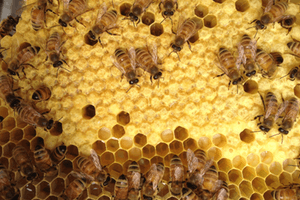- All-In-One Beekeeping for the Bees
- +1-608-728-8233
- info@beepods.com
Festooning: Three Theories About the Mysterious Bee-havior Stumping Scientists and Beekeepers Alike


As beekeepers, we’re often inspired by the many ways we see our bees working together and as a community to accomplish things in their hives. Just like we help each other by sharing information, techniques, and experience working with bees, bees communicate and collaborate to get things done.
But, there’s one inspiring example of bees working in concert that the beekeeping community just can’t figure out: Festooning. Nothing says “teamwork” like those little ladies creating chains across spaces in their hive. But why do they do it? One thing is for sure – they are working together and supporting one another. Let’s take a look at this heartening yet mysterious behavior.
What is Festooning?
Festooning is a simple, yet fascinating, bee-havior. It’s when a group of bees join up and link legs to create a single line, or chain, across space within the hive. While a chain of bees is undoubtedly an entertaining sight for any bee lover, festooning is more than a fun activity for them.
Festooning is a mystery to bee scientists and researchers. We know that bees are incredibly purposeful and efficient with their actions. Forming a festoon is certainly a step toward a goal in the hive. But no one has ever been able to pinpoint precisely what bees are trying to accomplish when they create a chain.
There are many theories out there as to why bees festoon. Here are some of the more popular ideas about why bees might do it.
Festooning and Comb Construction
Festooning is often observed when bees are creating new comb or fixing up their old comb. For that reason, some researchers believe festooning is a construction activity that signifies some serious comb-work is underway. Under this concept, bees may link up and festoon as means of working more efficiently.
Here, festooning serves as a scaffold or structure to hang and work as they build comb in a new spot. However, because festooning is sometimes observed when bees aren’t constructing comb, it’s tough to tell whether it’s something they do strictly for construction purposes.
Measuring Space with Festoons
Another common thought on festooning is that it’s a way bees measure distances within the hive. We know bees are very particular about where they build comb. As in, they will only build comb in spaces larger than 3/8 of an inch – known as bee space. It should come as no surprise, then, that bees would create ways to measure distances within the hive, and that perhaps, festooning is one method of doing so.
However, bees certainly build comb without festooning. So, do they only festoon when specific spaces don’t require measurements? Scientists don’t have an answer, but the concept of measuring distances by festooning could be a plausible one.

Bees festoon in downward chains on either side this bar of comb.
Festooning for Wax Production
Some bee researchers believe that festooning is something bees do to enhance their wax production. Bees secrete wax from glands in their abdomens and need a hive temperature of anywhere between 91 and 97 degrees Fahrenheit to do so. Some folks believe that when they link their legs together and cling to one another, they generate some bee heat. This is thought to warm their space and help them create the wax they need to build comb.
Challengers to this theory would point out that bees generate more heat when moving on top of or against each other. Plus, bees haven’t been seen actually excreting wax in a festoon. So, while it’s possible, like every other festooning theory, it hasn’t been proved (yet).
Closing Thoughts
Without any proven research on why exactly bees festoon, it’s hard to understand this charming activity. What we do know is that festooning is symbolic of bees working together to accomplish things. Whether they do so to construct comb, create wax, measure spaces, or for some other reason entirely, it’s inspiring to see those little ladies link legs. Maybe someday we’ll have a better understanding. In the meantime, it sure is fun to watch!
Beekeepers can learn and work together just like our bees do.
Beepods Lab membership gives you access to an exclusive community of beekeepers, scientists, teachers, and other bee experts.
Kanoe Riedel
Latest posts by Kanoe Riedel (see all)
- This Spring, Don’t Forget Why Bees Are So Important to Our Environment - March 26, 2021
- 11 Awesome Uses for Your Stored Honeycomb - March 2, 2021
- How the Right Beekeeping Equipment Makes Inspections Better for Beekeepers and Bees - February 12, 2021



